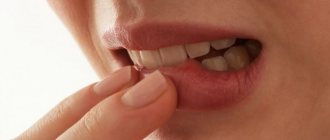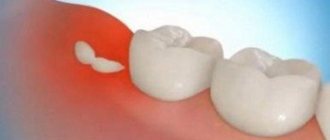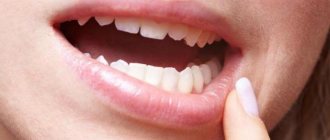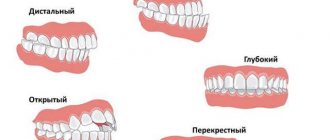July 11, 2017
Inflammation of the gums under the crown is by no means uncommon. The problem, of course, is not a pleasant one - after all, the tooth is finally restored and you want to forget about visiting the dentist. UltraSmile . ru is in a hurry to share useful information - why the gums become inflamed under the crown, what to do about it and whether it is necessary to see a doctor again.
Inflammation of the gums under a metal-ceramic crown
Reason 1: poorly treated tooth
Before installing a dental crown, the doctor will definitely remove the nerve, clean the canals and eliminate all sources of inflammation. However, if all these manipulations were not carried out correctly, re-inflammation may occur both inside the tooth and in the tissues surrounding it, including the gums. If the mucous membrane turns red, a lump or a purulent fistula appears on it, you need to immediately consult a doctor - you need to have time to save the tooth and prevent the infection from spreading throughout the body.
If you are faced with a disease such as pulpitis, be sure to insist on X-ray diagnostics. It should be carried out several times during the entire treatment: in the image, the doctor will see all the shortcomings, determine the number of tooth canals, the quality of their filling, and the tightness of the filling or crown. After all, it is poorly treated pulpitis, due to incorrect determination of the length of the canals (filling material extending beyond the apex of the tooth root or, conversely, insufficient quantity), that often becomes the cause of the development of a repeated inflammatory process.
Causes of local gingivitis
Any inflammatory process is the result of bacterial activity. In the case of the disease in question, there are several routes of infection; before treatment, it is important to accurately establish the true cause.
- Poor hygienic preparation of the oral cavity before installing a crown.
This is the most common cause of local gingivitis. Stages of installation of the structure - Injury to the gums by the prosthesis.
- Leaky crown (“unskilled actions of the dentist are to blame for this”).
- Incorrect bite and too much pressure of the crown on the gum.
Incorrectly installed crown
There are also secondary reasons that accelerate the development of the disease and complicate its treatment:
- poor nutrition;
- weakened immune system;
- hypothermia of the body.
Local gingivitis can also be caused by damage to the crown after its installation. The tightness is lost, as a result of which bacteria enter from the outside into “heavenly” conditions for reproduction.
Fistula
Video: The gums hurt, the tooth under the crown aches when pressed
Reason 2: incorrect installation of the crown
The modern method of installing a crown is as follows: the natural tooth is ground to a cone shape, while a flat base or ledge is left at its base (slightly under the gum). A crown is created in a similar way - inside it there is a cavity for the cone of the tooth, and along the edges there is a flat base. Thus, the artificial crown fits more tightly to the natural tooth, eliminating the risk of micromobility and the formation of gaps. But if the crown is created incorrectly and is slightly larger than the tooth, it can put pressure on the gum, causing injury and constant inflammation.
Today, the most accurate, one might even say ideal, positioning on the teeth is provided by crowns made of zirconium dioxide. They are created using advanced 3D modeling techniques and manufactured on a milling machine, which allows you to create ideal prostheses that best suit the anatomical features of the patient.
Symptoms
Gingivitis does not destroy teeth and soft tissues; the disease can only be determined by secondary signs:
- swelling of the gums;
- dental plaque;
- accumulation of white plaque (a sign of soft tissue necrosis);
- bleeding;
- bad breath;
- redness of the inflamed area.
Manifestations of gingivitis
With advanced gingivitis, there is an increase in temperature, and sometimes there is no pain until complications occur. In this case, the following symptoms are “added”:
- pulsation in the gum;
- tooth instability;
- exposure of the base of the tooth.
Gum recession
When such symptoms appear, more complex treatment is required than in the early stages of gingivitis.
Important! In rare cases, the inflamed gum may turn blue. This indicates a disruption of the blood supply and tissue necrosis.
Caries and pulpitis under dentures
Reason 4: old crown
Yes, do not forget that inflammation of the gums under the crown can occur as a result of the crown moving away from the walls of the tooth. Despite the fact that modern materials last a long time (10 years or more), they still gradually fail during operation. Their integrity may also be damaged as a result of too strong mechanical impact or injury. Naturally, in these cases, bacteria begin to accumulate under the crown, which provoke inflammation of the gums, and even the tooth itself.
To prevent this from happening to you, undergo preventive examinations in a timely manner; the dentist will quickly detect the defect and eliminate it before pathogenic microorganisms get under the crown.
Folk remedies
Methods of treating inflammation that we inherited from our ancestors can only be used in conjunction with the main treatment. They can only alleviate the symptoms and reduce the activity of bacteria, but folk remedies are not able to completely eliminate gingivitis. These methods are aimed at rinsing the mouth and compresses.
Table. Folk remedies for gum inflammation.
| Name, photo | Short description |
| Aloe juice | A great way to relieve pain and reduce swelling. You need to cut a leaf, peel it and apply it to the inflamed area. There may be a burning sensation, but it will quickly pass, and with it the painful sensations will disappear. Remember - aloe juice is very bitter, the aftertaste lasts for about an hour. |
| Chamomile and sage decoction | A tablespoon of herbal mixture is poured into 250 ml of boiling water. The decoction is infused for an hour, after which it is used for baths (this is not a rinse, you just need to put the product in your mouth and hold it on the side of the inflammation). |
| Oak bark | You will need 15 g of dry bark. Pour a glass of boiling water over it and leave for 40 minutes. Rinse your mouth 3 times a day. |
| Soda and salt | The most effective remedy for the discharge of pus. You will need a teaspoon of salt and soda per glass of warm (not hot) water. The product is thoroughly mixed. You should rinse your mouth at least three times a day, and after each meal. |
All of these products have proven themselves and are even recommended by dentists. In addition to relieving symptoms, they can strengthen the gums, preventing the development of new diseases.
Strengthening gums with herbs
Video: Eliminating gum inflammation under crowns
Reason 5: insufficient oral hygiene
If you think that teeth restored with crowns do not require daily care, then you are mistaken. They also require attention and must be cleaned; the gums can be treated with mouth rinses. So, you will not give bacteria a chance to “start” their destructive activities.
Do I need to see a doctor?
First of all, it is necessary to eliminate the cause that caused the inflammation. And this, of course, can only be done by a doctor. It will be necessary to re-treat the tooth and eliminate the purulent focus. Antibiotics may be prescribed. If the cause is a poorly made crown, it needs to be replaced - and it is better to contact another doctor and dental technician for this, since your doctors clearly did not cope with the job.
Timely visit to the dentist is the key to oral health
If the cause of gum inflammation is a violation of the shape of the crown, a new one cannot be installed until the mucous membrane is cured. To begin with, it is important to carry out symptomatic therapy and only then proceed with repeated prosthetics.
Treatment methods for sore gums
After eliminating the cause, you can proceed directly to relieving the inflammatory process. It is worth considering that drugs are prescribed only by a doctor, based on the condition of the gums.
Among the safest products that can be used at home for rinsing, baths or applications with a cotton swab soaked in the preparation are the antiseptics “Chlorhexidine” and “Miramistin”, herbal infusions “Rotokan” and “Stomatofit” (they are alcohol-based, so they have restrictions on application), as well as various herbal infusions that just need to be poured with boiling water. If you follow the instructions, they will not cause harm, but you should still consult a doctor before using them.
Antiseptics for mouth rinses
If your gums under the crown are inflamed, then you should not hesitate, because in such a situation there is a risk of the process spreading to deeper tissues, even leading to tooth loss. Be sure to make an appointment with a specialist who will determine the nature of the problem and prescribe the most appropriate course of treatment.
Notice
: Undefined variable: post_id in
/home/c/ch75405/public_html/wp-content/themes/UltraSmile/single-item.php
on line
45 Notice
: Undefined variable: full in
/home/c/ch75405/public_html/wp-content /themes/UltraSmile/single-item.php
on line
46
Rate this article:
crown
Treatment methods
To effectively eliminate the problem, a comprehensive therapeutic approach is required. Usually the doctor prescribes medications and also recommends that the patient additionally use traditional methods, for example, rinsing the mouth with a decoction of herbs. In some cases, the prosthesis will have to be removed and replaced with a new one.
Removing the crown
If the cause of bleeding is improper installation of the orthodontic structure, then the only treatment method is to remove it and reinstall it. After the crown is removed, the doctor checks whether there is a need to carry out sanitation (it may be necessary to re-clean and refill the root canal, remove a tumor, etc.). After eliminating the existing problem, the doctor selects a new crown for the patient and installs it.
Old crowns become very deformed when they are removed, so they cannot be reused.
In the frontal zone, in most cases, it is possible not to remove the crown, but to carry out the necessary manipulations directly under it, for example, to clean and fill the root canals. As a rule, such treatment is a temporary measure when there is no other option.
Drug therapy
If there is bleeding from under the crown, therapeutic treatment may be prescribed
If there is bleeding from under a crown or denture, the doctor may prescribe the following types of medications to the patient:
- Antiseptics. Antiseptics are used to rinse the mouth. Typically, dentists prescribe solutions such as Furacilin, Miramistin, Chlorhexidine or hydrogen peroxide. They disinfect the oral cavity well
- Antimicrobial drugs. Plant-based products fight microorganisms well: Rotocan, Tantum Verde, Chlorophyllipt. For the healing of soft tissues, ointments or gels are used: Cholisal, Metrogil-denta, Solcoseryl
- Antibiotics. If dental problems are caused by a bacterial infection, the patient is prescribed a course of oral antibiotics. Commonly used: Amoxicillin, Doxycycline, Gentamicin or Lincomycin
- Antifungal agents. Antifungal drugs are effective for candidal stomatitis. Flucostat, Diflucan, Imudon, Mikosist, Pimafucin, Nystatin have proven themselves well
Why does tooth inflammation occur under the crown?
Before prosthetics, it is customary to depulp the tooth, which is covered with a prosthesis. If for some reason the doctor did not do this, then if the structure does not fit tightly to the gum, secondary caries may develop, which causes pain. If the root canals are sealed, then the causes of inflammation lie in the following:
- incomplete canal filling;
- perforation of the channel during processing;
- presence of a foreign body in the canal (piece of instrument);
- abrasion of the prosthesis;
- loose fit of the prosthesis to the gum tissue.
How to detect inflammation?
As a rule, when a patient approaches, the doctor must do an initial external examination. If the dentin and pulp are damaged, or the enamel is damaged, the condition of the gums will not change. But if the problem is found in the root sheath, then inflammation will be visible. In this case, the doctor will find:
Sign up for a free consultation:
- there is a hole on the gum surrounded by granulations, indicating the development of a fistula;
- redness of the thickened edge of the gum and tartar - this is pronounced gingivitis (if you press on the gum, an imprint will remain from the instrument);
- pus may flow from under the gingival margin, which indicates chronic inflammation of the gums;
- the subgingival abscess will have an elongated bulge where there is a transition between the gum and cheek.
Blood under a clasp prosthesis is a relatively rare occurrence, and a routine preliminary examination may not be enough to understand the true cause of its formation. X-rays can be used for this. It will reveal the occurrence of neoplasms or damage to the tooth root, including perforation of the cavity walls, crack, fracture or caries in the internal part. This research method makes it possible to see an abscess or cyst; they cannot be detected during an external examination.
Possible complications after prosthetics
When installing a crown, the dentist has to carry out a huge amount of preparation, the quality of which determines the patient’s further comfort. It begins with the removal and treatment of carious teeth, the production of perfectly accurate implants and their attachment to the stump. During the first few days a person gets used to the structure, it rubs in and falls into place. Therefore, it is considered quite natural that the gums at the crown bleed and slight swelling appears.
Such problems are quite predictable in the following cases:
- in women during menstruation or with increased progesterone hormone;
- with blood clotting disorders and low potassium;
- with diabetes or high sugar levels.
Therefore, in preparation for prosthetics, experienced dentists include a whole set of tests, examination of the oral cavity, and even allergy tests to dental material. But the best selection does not guarantee 100% survival rate and absence of complications. The most common problems that cause crowns to bleed above or below the gums are:
- The ratio between the size of the prosthesis and the thickness of the mucous membrane was not observed; there was a violation in the process of manufacturing a ceramic veneer or implant. They press and cause swelling, causing the patient to experience discomfort.
- When preparing a tooth or root canal, pathogenic bacteria enter and an infection occurs. In this situation, suppuration of the tissue begins, and the gums rise at the site of accumulation of exudate. When pressure is applied to the crown, a cloudy liquid with a putrid odor emerges.
- A secondary form of caries develops, which leads to damage to the remaining tooth under the bridge. Such a patient has an unpleasant taste in the mouth, reminiscent of sourness.
In any case, the help of a dentist is necessary. Many patients try to eliminate inflammation on their own, so as not to remove expensive prostheses and avoid re-implantation. This leads to the development of sepsis, death of gum tissue or painful fistulas.
Factors that provoke inflammation
Pathology can occur either due to injury or due to violation of the manipulation technology. The most common causes of inflammatory processes:
- Poor fixation of the crown. If there is a gap between the denture and the tooth, food particles get there and cause bacteria to multiply.
- Entry of a foreign body. If the rules for working with instruments are not followed, steel needles can break and get stuck inside the tooth. This can happen when using old equipment, severe curvature of the root canals, or exceeding the curing time of the filler during filling.
- Root perforation. If the doctor accidentally injured the root of the tooth during prosthetics, an inflammatory process develops at the site of damage. In order to detect pathology in a timely manner, it is recommended to take x-rays not only before starting treatment, but also after it.
- Poor quality depulpation. Before installing a metal-ceramic or solid-cast crown, the dental nerve must be removed. If depulpation was done carelessly or the canal is not hermetically sealed, pathogenic microflora multiplies in the tissues.
- Diabetes mellitus, dysfunction of the cardiovascular system or digestive organs.
- Weak immunity.
- Hormonal imbalance.
- Lack of vitamins and minerals.
- Failure to comply with hygiene rules.
- Exceeding the permissible service life of the prosthesis.











